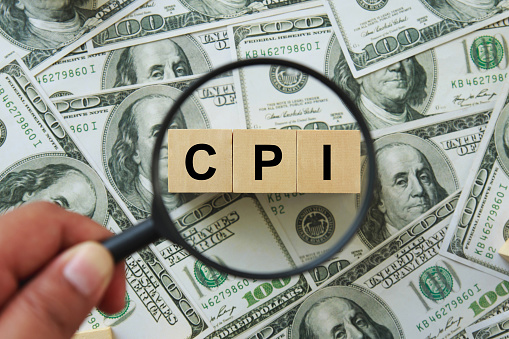
I . Three important indicators to measure the macro economy: CPI, PPI and PMI
(1)What Is the Consumer Price Index (CPI)?
The Consumer Price Index (CPI), known as the composite Consumer Price Index in Hong Kong and the Consumer Price Index in Taiwan, is an indicator of Price changes calculated to reflect the prices of products and services related to people's lives in economics. It is expressed as percentage changes. It is one of the main measures of inflation. More than 3% is generally defined as inflation, and more than 5% is a relatively serious inflation.
CPI is often an important reference index for market economic activities and government monetary policies. Stable CPI, full employment and GDP growth are often the most important socio-economic goals. If consumer prices rise too much, indicating that inflation has become a destabilizing factor for the economy, the country risks tightening monetary and fiscal policy, creating uncertainty about the economic outlook. As a result, too high a rise in the index is often unwelcome. Available means are interest rate increase, tight monetary policy, adopt prudent fiscal policy, increase production, calm prices and so on.
KEY TAKEAWAYS
- The Consumer Price Index measures the overall change in consumer prices based on a representative basket of goods and services over time.
- The CPI is the most widely used measure of inflation, closely followed by policymakers, financial markets, businesses, and consumers.
- The widely quoted CPI is based on an index covering 93% of the U.S. population, while a related index covering wage earners and clerical workers is used for cost-of-living adjustments to federal benefits.
- The CPI is based on about 94,000 price quotes collected monthly from some 23,000 retail and service establishments as well as 43,000 rental housing units.
- Housing rents are used to estimate the change in shelter costs including owner-occupied housing that account for nearly a third of the CPI.
II . What Is the Producer Price Index (PPI)?
The Producer Price Index (PPI) is an Index used to measure the average change in factory gate prices of manufacturers. It is one of several Price indices collected and collated by statistical departments. If the producer price index is higher than expected, there is a risk of inflation. If the producer price index is lower than expected, it indicates a risk of deflation.
KEY TAKEAWAYS
- The Producer Price Index measures change in the prices paid to U.S. producers of goods and services.
- The PPI is a measure of wholesale inflation, while the Consumer Price Index measures the prices paid by consumers.
- The index is published monthly by the Bureau of Labor Statistics.
- PPI indexes are calculated based on products and services, industries, and the buyer's economic identity, which are used to calculate the overall monthly change in final demand PPI.
- The indexes calculate price changes in private contracts based on suppliers' input prices.
III. What Is the Purchase Management Index(PMI)?
The Purchasing Managers' Index (PMI) is an index of the prevailing direction of economic trends in the manufacturing and service sectors. It consists of a diffusion index that summarizes whether market conditions, as viewed by purchasing managers, are expanding, staying the same, or contracting. The purpose of the PMI is to provide information about current and future business conditions to company decision makers, analysts, and investors.
KEY TAKEAWAYS
- The Purchasing Managers Index (PMI) is a measure of the prevailing direction of economic trends in manufacturing.
- The PMI is based on a monthly survey of supply chain managers across 19 industries, covering both upstream and downstream activity.
- The value and movements in the PMI and its components can provide useful insight to business decision makers, market analysts, and investors, and is a leading indicator of overall economic activity in the U.S.
IV. How does the index affect the economy?
CPI, PPI and PMI are important economic indicators that reflect the macroeconomic situation and serve as important references for national policy making.
Key Takeaways
- The Consumer Price Index (CPI), the producer price index (PPI), and the Purchasing Managers' Index (PMI) are three essential index numbers that measure the macroeconomy.
- Both CPI and PPI measure price changes from the perspective of consumers and producers.
- PMI signals economic expansion and contraction. A reading above 50 indicates expansion, and anything below shows contraction.
V. Understanding
Summary:CPI, PPI, and PMI are important indicators compiled and released regularly in major global economies. Observing the changes in these indicators can help us effectively analyze the economic environment and the inflation level and make investment decisions.
Understanding CPI, PPI and PMI
The Consumer Price Index (CPI), a common measure of inflation and deflation, reflects price changes over time for a basket of goods and services purchased by typical households. The contents of the measured basket and the weights of categories can vary by region and country. The rate of CPI's short-term rise or fall can, to some extent, reflect the current economic environment. The more CPI rises, the more likely there will be inflation.
The Producer Price Index (PPI) measures the change in prices paid to producers for their output, including raw materials and labor services. The weights of categories of PPI vary in different countries and regions but basically cover the price changes in three stages: raw materials, intermediate goods, and finished goods.
The PPI and CPI are interrelated. Generally speaking, when PPI continues to rise, the upstream producers will more or less pass on rising costs to consumers, leading to elevated CPI.
The Purchasing Managers' Index (PMI) measures the prevailing direction of economic trends based on a survey of purchasing managers across various industries, including manufacturing PMI, services PMI, and architecture PMI. PMI tracks new orders, production, supplier deliveries, inventories, the backlog of orders, and employment. A PMI reading above 50 indicates expansion, while below 50 means contraction. The further away from 50, the greater the level of change.
 Global
Global Singapore
Singapore Hongkong
Hongkong Group
Group